The Hipodromo Argentino of Palermo is a classic Buenos Aires destination that harkens back to Buenos Aires’ own Belle Époque.
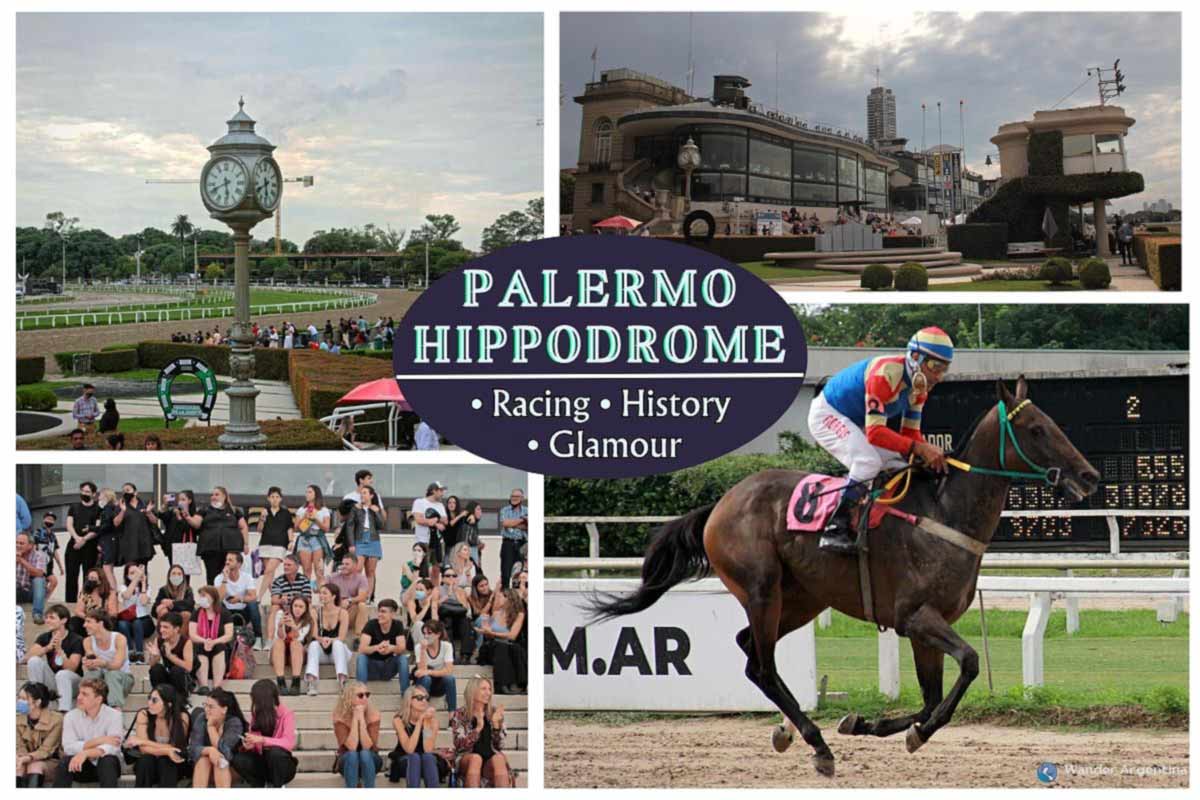
Wander the racetrack’s manicured grounds, dotted with marble statues and Jacaranda trees.
Witness the athleticism of jockeys and horses at close range and get caught up in the razzmatazz of the races.
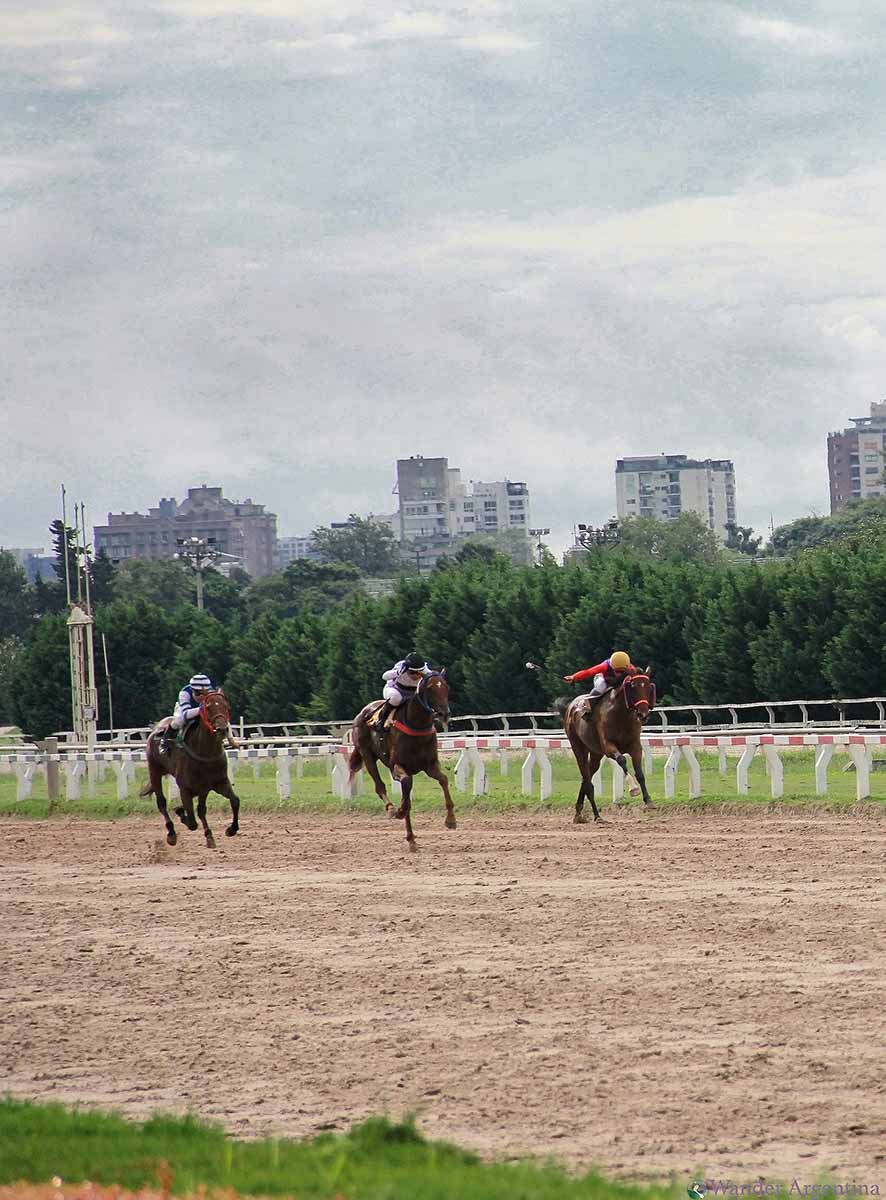
Horse racing right in Palermo
The Legacy Gallops on: Argentina’s Oldest Horserace Track
Argentina’s oldest continuous racehorse track dates to 1876, reigning over a large parcel of the northern part of Buenos Aires’ vibrant Palermo neighborhood.
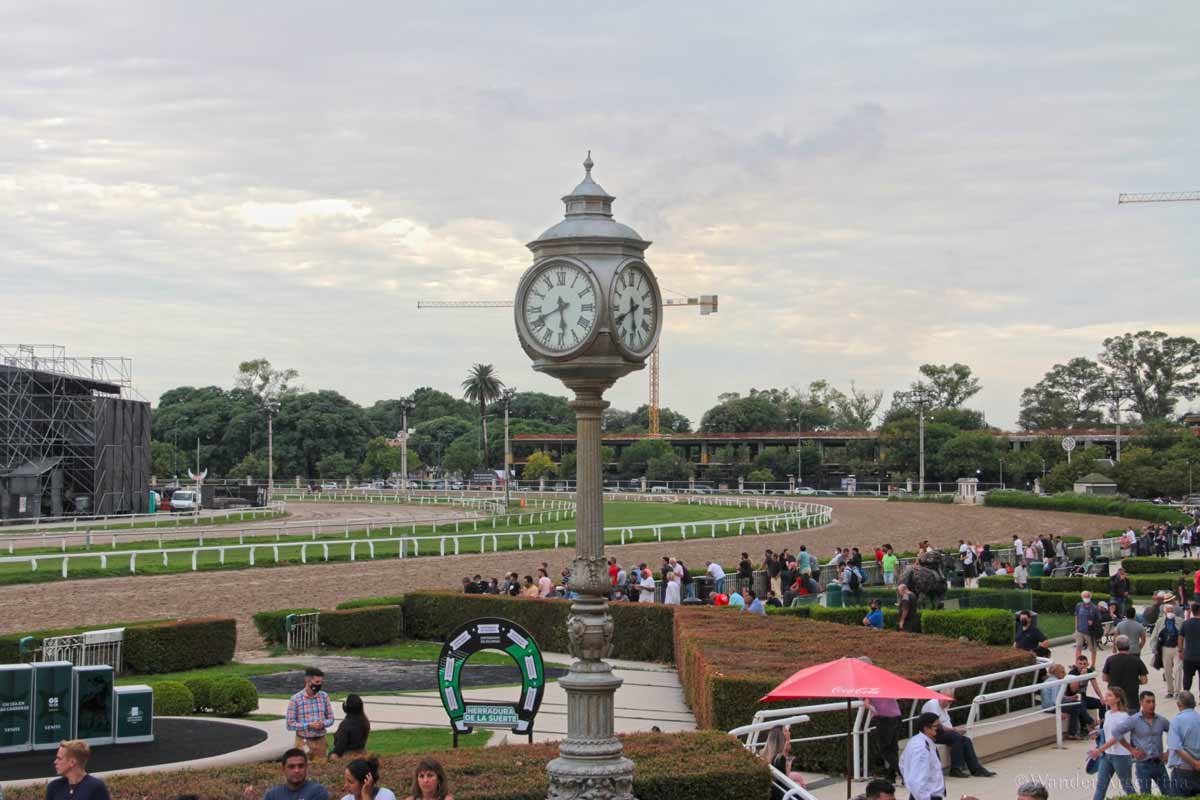
Flat-track races take place nine months of the year.
Beyond the thrill of the races, the hippodrome hosts music concerts, DJs, festivals and fashion shows on the sprawling grounds.
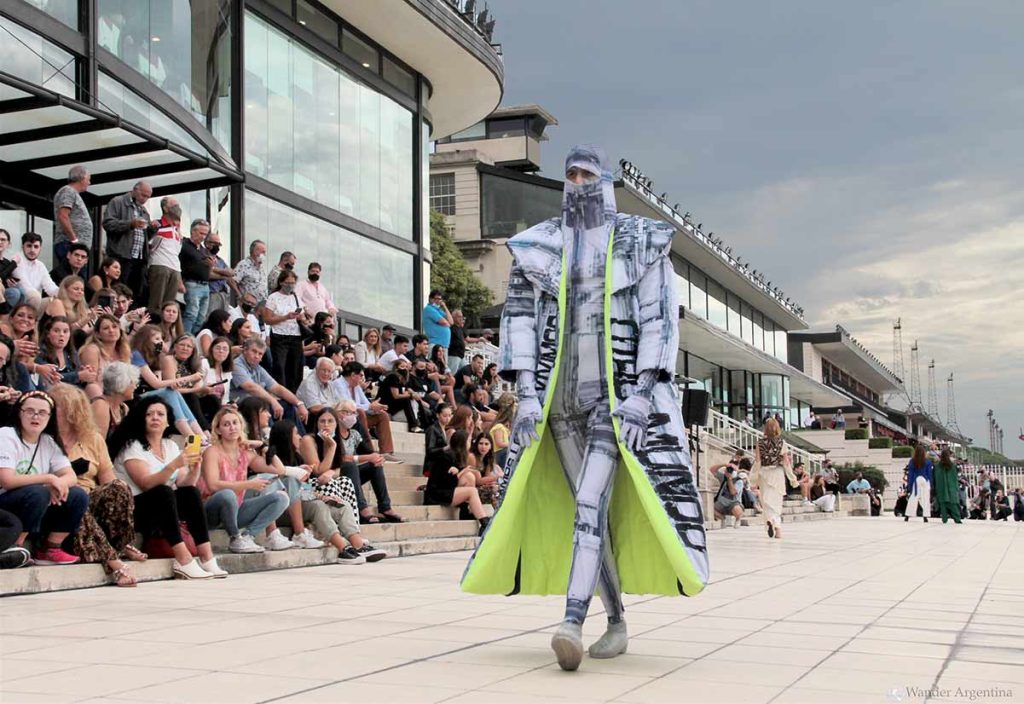
Who knew 21st century fashion would be as cumbersome as in the 19th century?
The former ‘Confitería Paris,’ built in 1912, is now beautiful microbrew pub with a large outdoor dining area.
Two American-style restaurants — one named after a U.S. city and the other a state — are popular on holidays when foreigners in Buenos Aires seek out holiday comfort foods.
Lest visitors forget they are in the 21st century, there is a huge basement casino, where thousands of flashy slot machines gobble up money 24 hours a day, seven days a week.
Argentina’s Equestrian Tradition
Horse racing is a centuries-old sport, but the evolution of Argentina’s equestrian tradition differs from that of the UK or North America.
Horses were first brought to Argentina by the Spaniards in the 1500s. The wild horse population flourished on the fertile pampas.
While there was heavy investments in the nation’s railways at the time (including the historic Patagonia Express) the Hipodromo Argentino was being built, owning a horse was the norm on the Argentine pampas. Even having a few horses hardly served as an indicator of wealth.
“In a country where the national myth is a man on horseback — the gaucho — it should not be surprising that the racetrack was, until well into the 20th century, more popular than soccer,”says Roy Hora, author of ‘Historía del turf Argentino’ (History of Argentine Horse Racing).
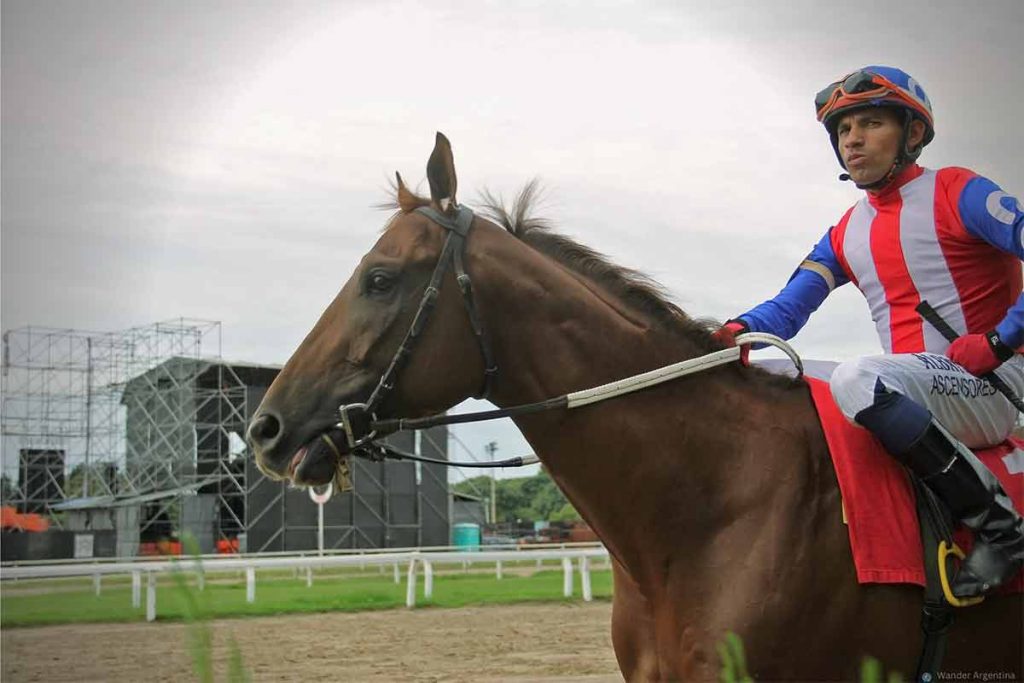
“In 19th century Argentina there were more horses than people, and they were also very cheap, so everyone had first-hand knowledge of these animals.”
Long before the emergence of flat track horse racing in Argentina, gauchos practiced their own equestrian races and games (such as the ring race, as seen at San Antonio’s Gaucho Festival) and sometimes had duals, right on the terrain where the hippodrome currently stands.
A Belle Époque Hotspot in Buenos Aires
‘Turf’ as horse racing is called in Argentina, was the nation’s primary spectator sport when the hippodrome was inaugurated.
Like Polo, the other ‘Sport of Kings’ (played at the ‘Campo de Polo’ across the street) the competitions were managed by high society, who considered it more ‘civilized’ than gaucho games.
At the time, Buenos Aires was considered the most prosperous city in Latin America.
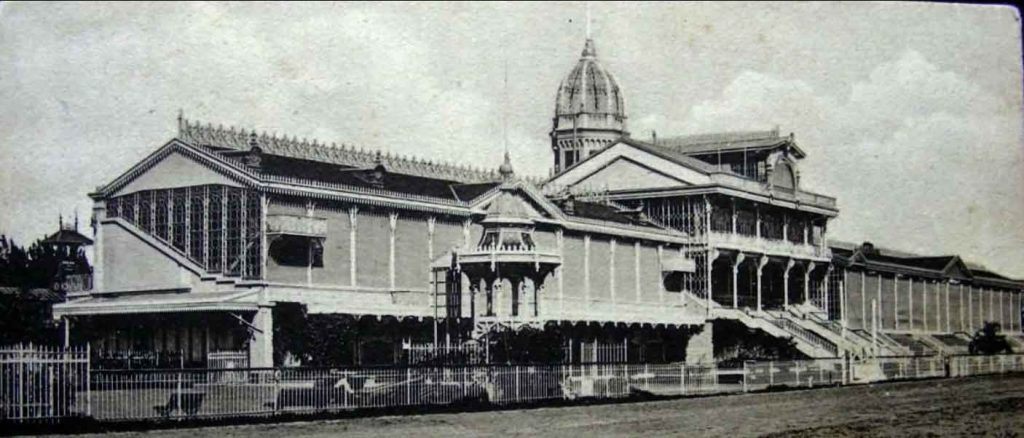
With a push to attract immigrants from Europe, it was a hub for commerce, sport, intellectual life and arts.
Demand for Argentina’s agricultural exports were in high, and money was rolling in from foreign investment.
Argentina’s ‘Generation of ’80‘ were eager to construct the ‘Paris of South America,’ adopting a French architectural style.
Large avenues were designed, forking out from the Plaza de Mayo and sprawling plazas and parks such as nearby Buenos Aires Botanical Garden, and San Telmo’s Parque Lezama were landscaped throughout the city.
Downtown Buenos Aires department stores such as Harrods Buenos Aires, Au Bon Marché (the current location of Galería Pacíficos) and Gath and Chaves spared no cost in creating shopping meccas worthy of the prosperity of the era.
A spectacular hippodrome was an essential part of the cosmopolitan city’s needs.
Palermo Hippodrome’s widely anticipated 1876 inauguration attracted ten thousand attendees, clad in their burdensome Victorian outfits.
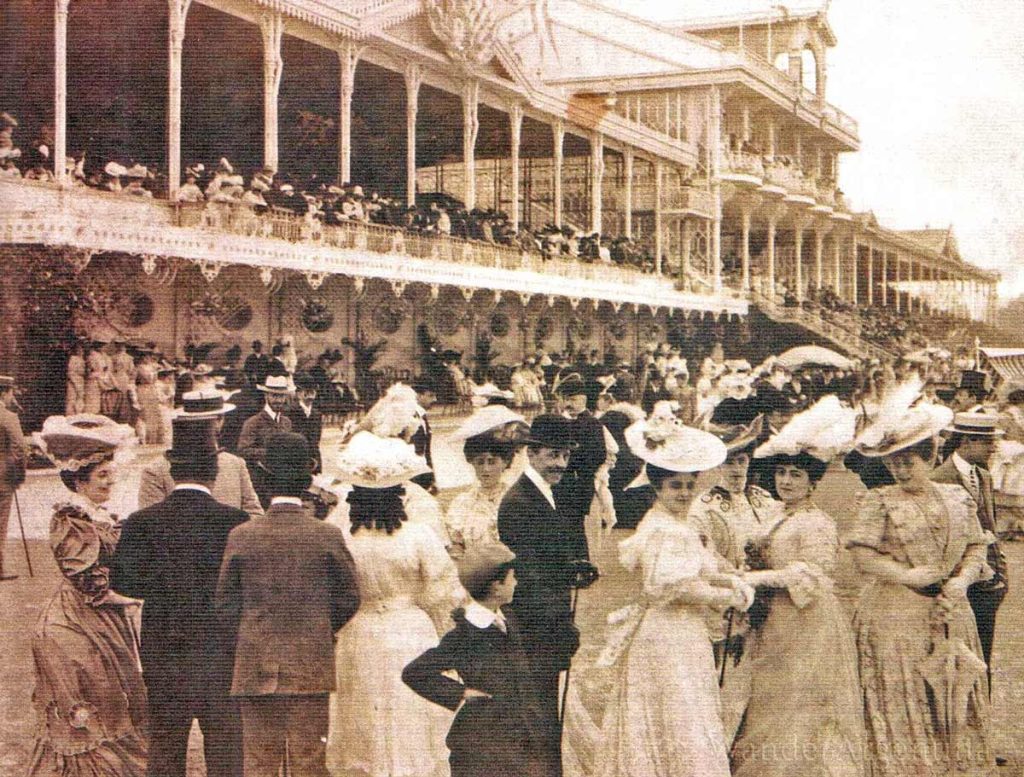
Extra trolleys brought in spectators from the neighboring Belgrano neighborhood and they waded through mud caused by previous rains to make sure they showed up for the paparazzi of the day.
While newspaper accounts of the time described opening day as an ordeal, the turnout highlighted the enthusiasm for horse racing in Argentina.
It was evident upon debut that the original grandstand wasn’t big enough.
In 1908, the Jockey Club knocked down the previous beautiful, but flammable, wooden grandstand and contracted École des Beaux-Arts trained architect, Louis Faure-Dujarricin to design a new neoclassical grandstand.
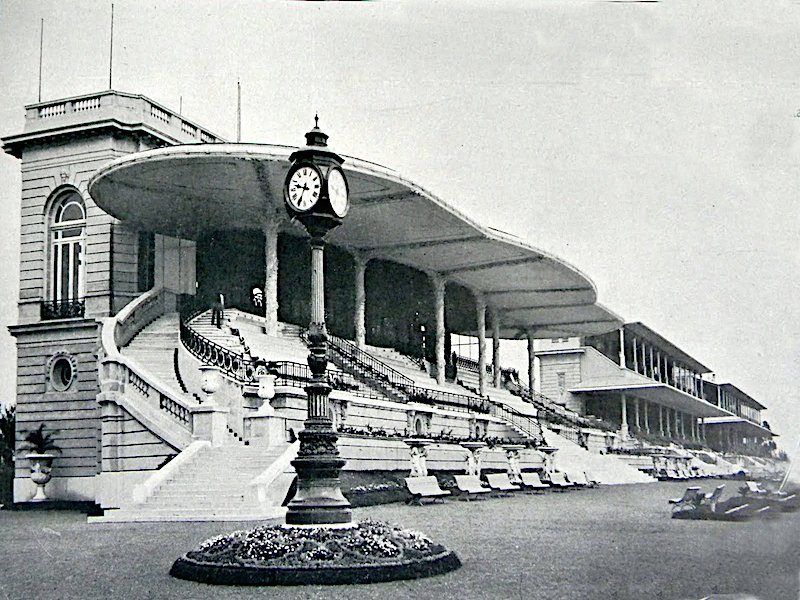
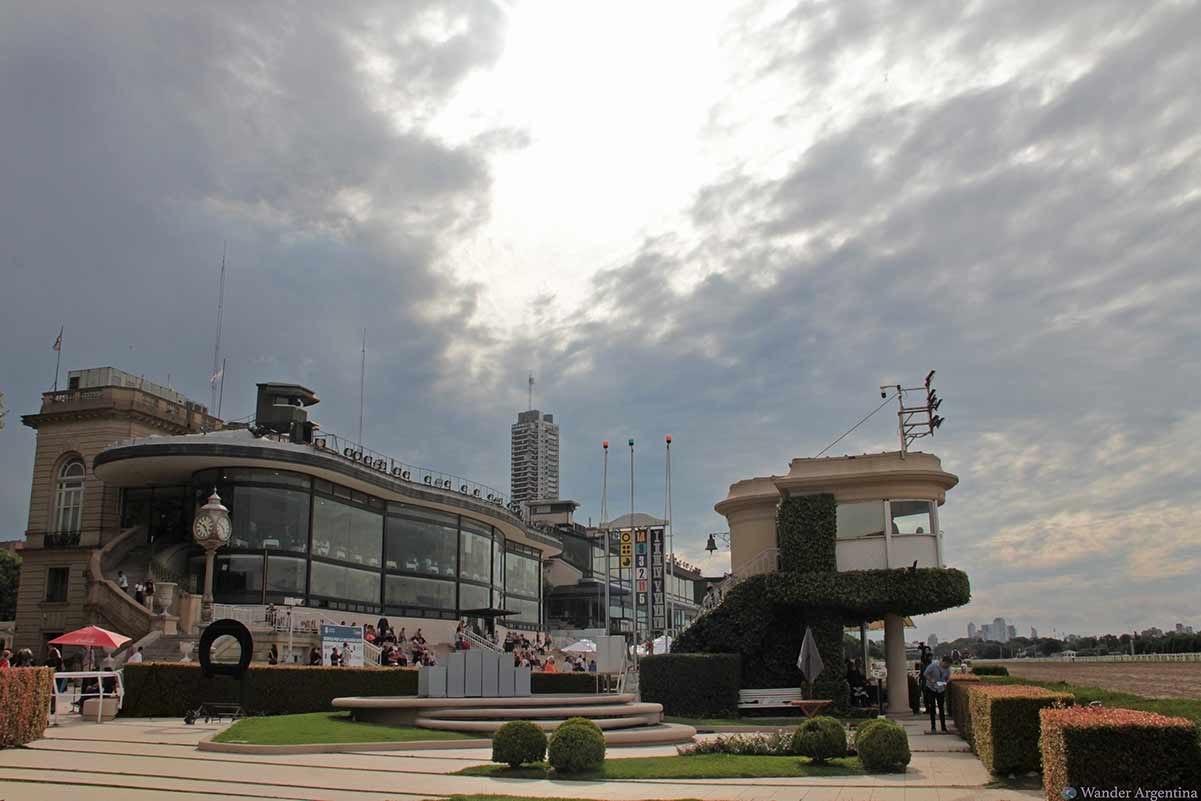
(The French architect, a dandy known to ride around town in his Royce Rolls, also designed the lovely Retiro train station, where visitors can get a train to Tigre for the price of a piece of candy. )
After Faure-Dujarricin’s celebrated renovation, the Hipodromo Argentino remained the largest horse racing complex in Latin America for half a century.
In the time since, the Jockey Club relocated their headquarters to the northern suburb at the larger Hippodrome of San Isidro.
Behind the Scenes: Visit the Paddock
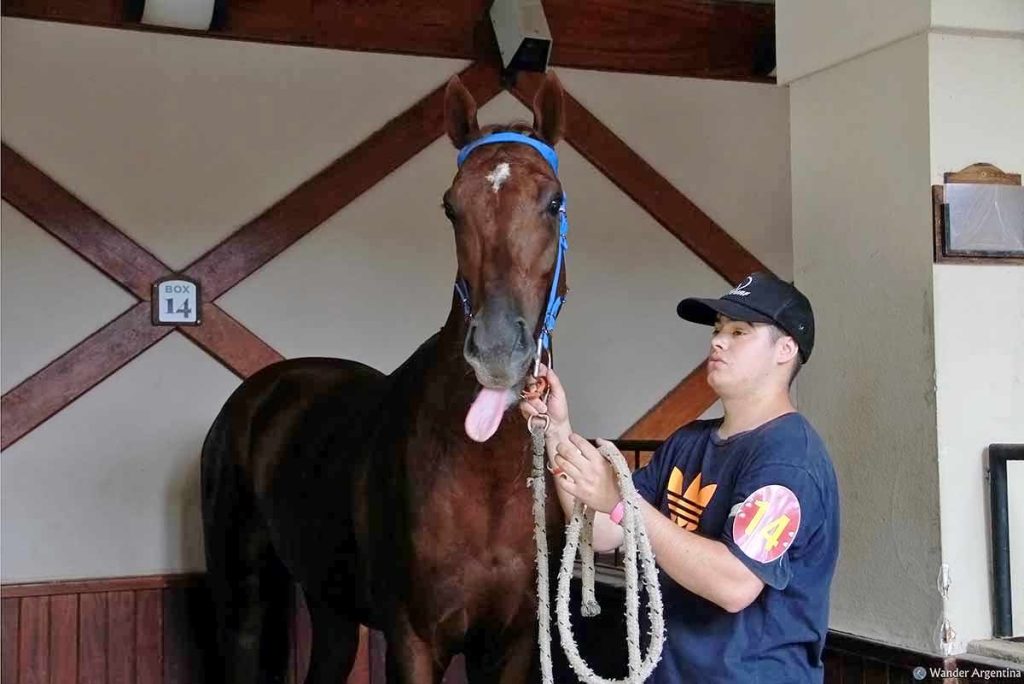
Visitors can see the young racehorses being cared for in the paddock. Horse trainers are with their horses every day, year-round.
Most of the stable workers are from rural areas where they farmed with the criollo horses used by gauchos, a long way from the shiny shopping mecca’s of surrounding Palermo neighborhood.
Before the races, each competitor is saddled, mounted and taken out of the paddock for a pre-game trot around the parade ring.
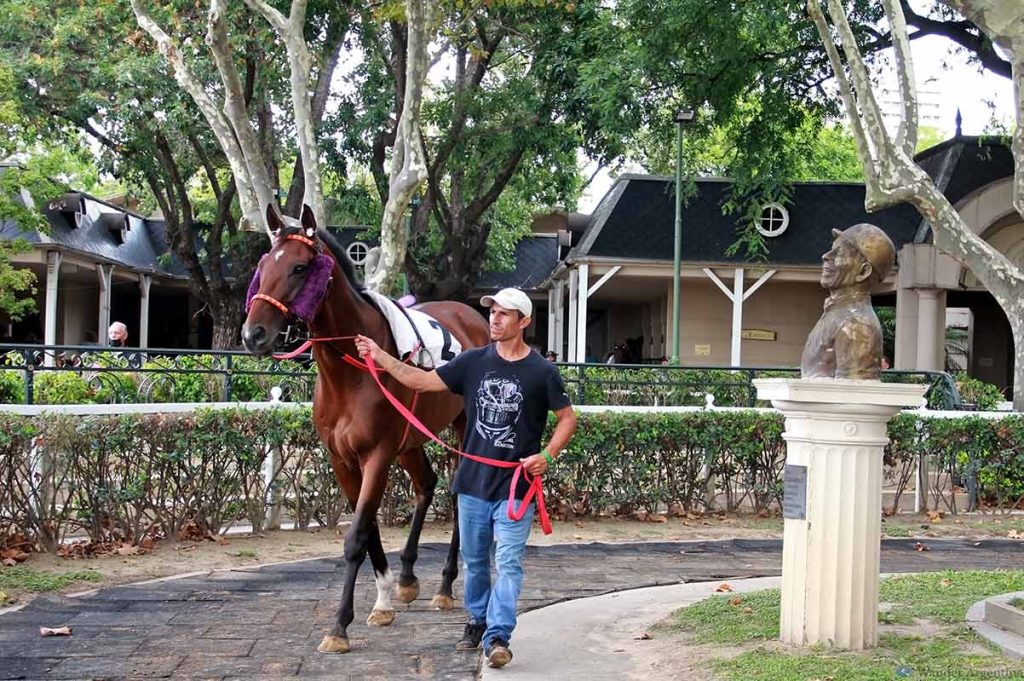
Being able to observe the temperament of the beautiful beasts before the race is an advantage for observant betters as they can see the horses’ condition and disposition before competition.
Visitors can hang out track side to be up close up to experience the power of the horses thundering by at full speed.
Races can also be observed in the stands or the windowed restaurants and salons overlooking the racecourse.
Betting on a Horse
After visiting the stalls and picking your horse or studying the rankings, betting is pretty straight forward.
Go to one of the betting huts marked ‘Apuestas‘ (Bets) located near the Grandstand, name the horse you want to bet on, and then indicate whether you think it will be a either ‘ganador’ (winner — #1), ‘segundo’ (second —#2), or ‘tercero’ (third – #3).
The number of the horse is marked on the starting gate as well as on the horse.
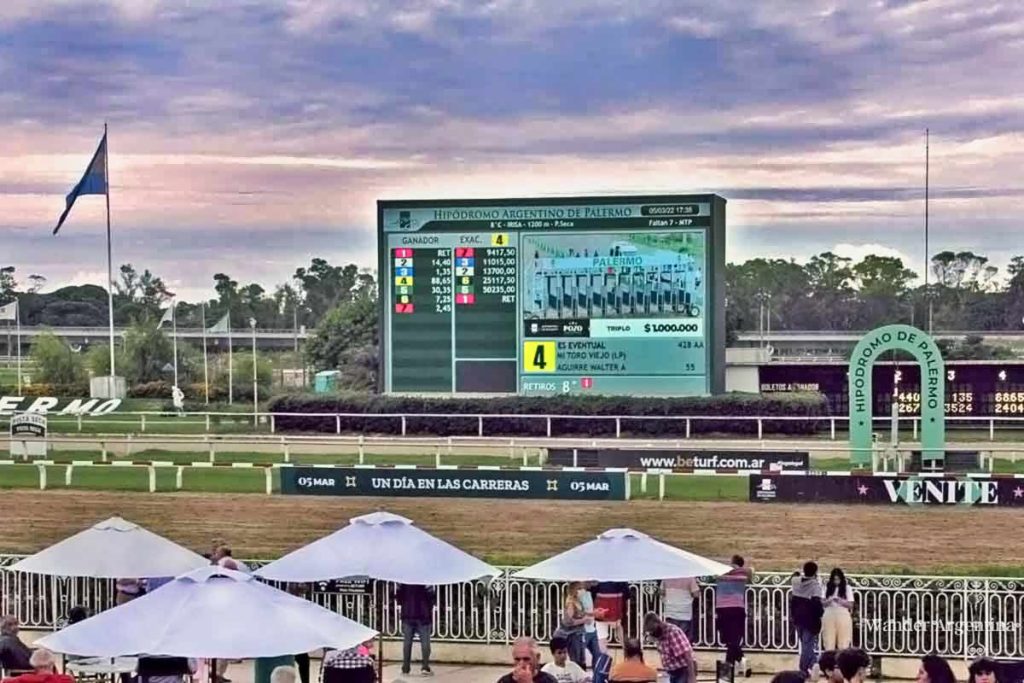
Even if you don’t speak Spanish, local bettors in line will probably help — and hopefully not throw you off.
The minimum bet is very low, so making a bet for the novelty will mean you don’t lose too many pesos.
After the race, the results are listed on the digital scoreboard and the action replayed on a screen by the track.
When the announcer yells out, “Se Paga” (Pay out) on the loudspeaker, the lucky winners can go collect their prize.
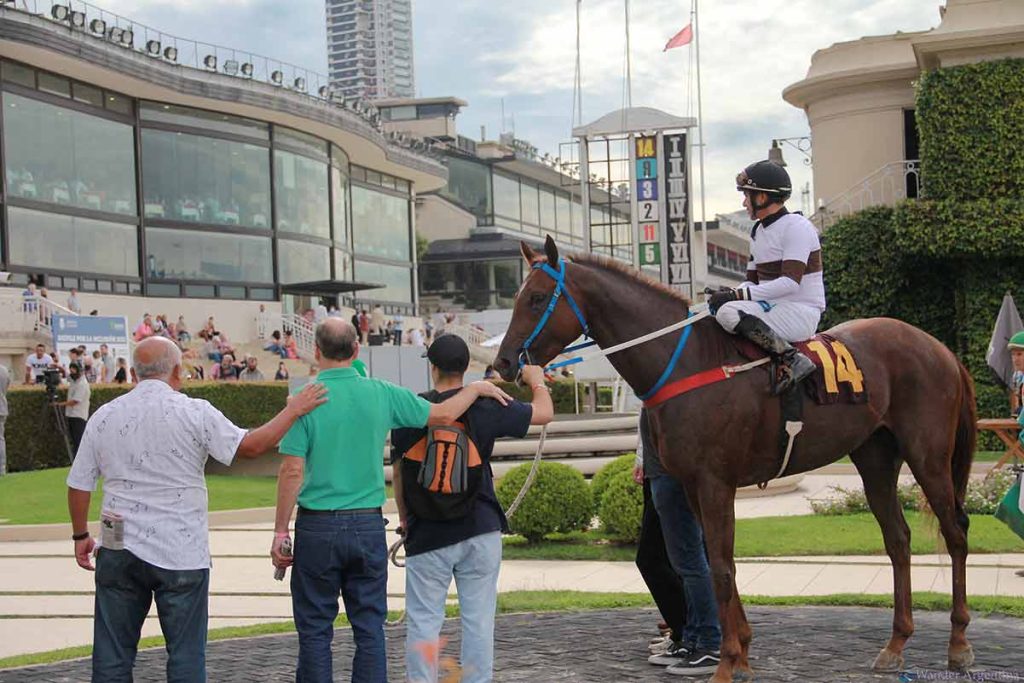
The Argentine Derby
During the lovely spring months of October and November the Triple Crown takes place.
The competition culminates in the derby, the ‘Gran Premio Nacional‘ in mid-November.
Dating to 1884, it is a 2500-meter (1.6 mi) run with three-year-old colts competing for the most prized trophy.
It’s the ultimate showcase of Argentina’s finest race horses, broadcast around the world.
The purse is the Argentine peso equivalent to US$150,000.
Unlike the U.K’s Grand National or the U.S. Kentucky Derby, where ticket prices reach US$2,500, entrance to see the races at the Palermo Hipodromo are free.
Inaugurating the races are General San Martin’s renowned horseback regiment, the Granaderos, who you can also see changing the guard everyday in the Plaza de Mayo.
The troops march in their dapper getups to perform a rendition of the Argentina national anthem before the main race (you can see it here — video opens in a new window).
Women in Horse Racing
Did you know..?
Horse Racing is one of the few sports where men and women compete against each other?
On this track in 1976, Marina Lezcano was the first women to win the ‘Gran Premio Nacional,’ the highest prize in Argentine horse racing.
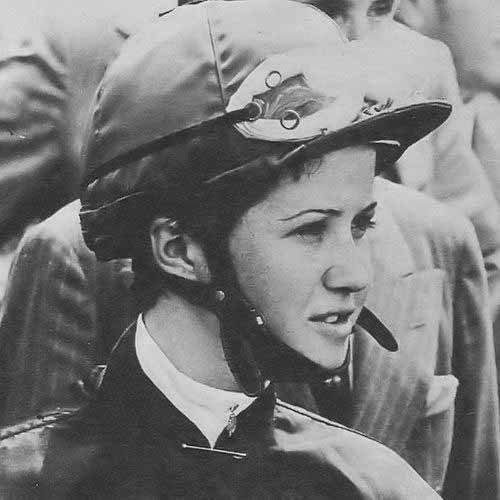
Making Way for Slot Machines and Sports Bars
For decades, horse racing was the dominant sport on Saturdays in Argentina.
But Argentina’s national soccer league was formed during the same era that the Palermo race track was built.
Sundays in Argentina eventually gave way to soccer.
Once Argentina won their first World Cup in 1978, soccer dominated even more and the Palermo Hippodrome stopped being a hot spot.
In 1992 the racecourse was privatized and incorporated by the Hipódromo Argentino de Palermo Sociedad Anónima (HAPSA).
In exchange for renovating the palatial grounds in 2008, the owners retained permission to put thousands of slot machines — today’s main money maker for the complex.
The basement casino has over 4,000 slot machines — more than any other casino in the country.
Slot machines are called ‘tragamonedas‘ in Spanish, literally ‘coin swallowers,’ and that’s what the slick machines here do 24 hours a day.
In a nod the old school vibes, one area of the casino is dedicated to smokers.
A sports bar in the casino is billed as the largest sports bar for betting in Latin America and has large TV’s so, it’s a solid option for those who want to watch professional sports from around the world.
Taking on the old motto, “You haven’t lost until you leave” the in-house gambling app Beturf, launched in 2020, enables users to keep betting long after they’ve left.
Those who like to gamble like Gardel should beware: Argentina’s gambling laws are lax and betting apps allow users to bet on any professional sport on the planet in real time.
The app’s AI is also designed to keep the individual user betting.
In the wild west of gambling apps losses can be disguised as wins and after gathering users’ financial details, they can even extend lines of credit.
Smartphone betting is considered more addictive than the simple analogue horse bets outside, so before downloading the app be sure you know when to “hold ’em and when to fold ’em” (in the words of the late Kenny Rogers.)
Tango, Gardel & the Hippodrome
Tango aficionados know there exists a cross-over between tango and horse racing.
Many tango musicians, including Carlos Gardel, Argentina’s most renowned tango singer, himself considered a stud, spent lots of leisure time at the track.
Gardel’s famous tango song ‘Por una cabeza‘ (Only a Head) uses equestrian slang of Rio de la Plata to draw parallels between the pain of losing at the racetrack and heartache.
In his song ‘Palermo,’ (named for this hippodrome) Gardel refers to the complex as a ‘cradle of prisoners.’
Lyrics such as, “Damn you, Palermo, you have me thirsty and sick, badly dressed and unfed” express the self-imposed hardships associated with gambling — the perfect subject matter for the melodramatic tango.
Even though he lost more than he won, Gardel owned several racehorses, the famous being Lunatíco (Lunatic).
He purchased the horse here at Palermo’s Tatterhall for a bargain; the horse had a head injury and a limp.
With his close friend, jockey Irineo ‘El mono‘ Leguisamo, they discovered Lunatíco’s stubbornness was his strength.
Lunatíco was a surprise winning horse, not only for Gardel, but his fans who considered it the underdog ‘People’s horse.’
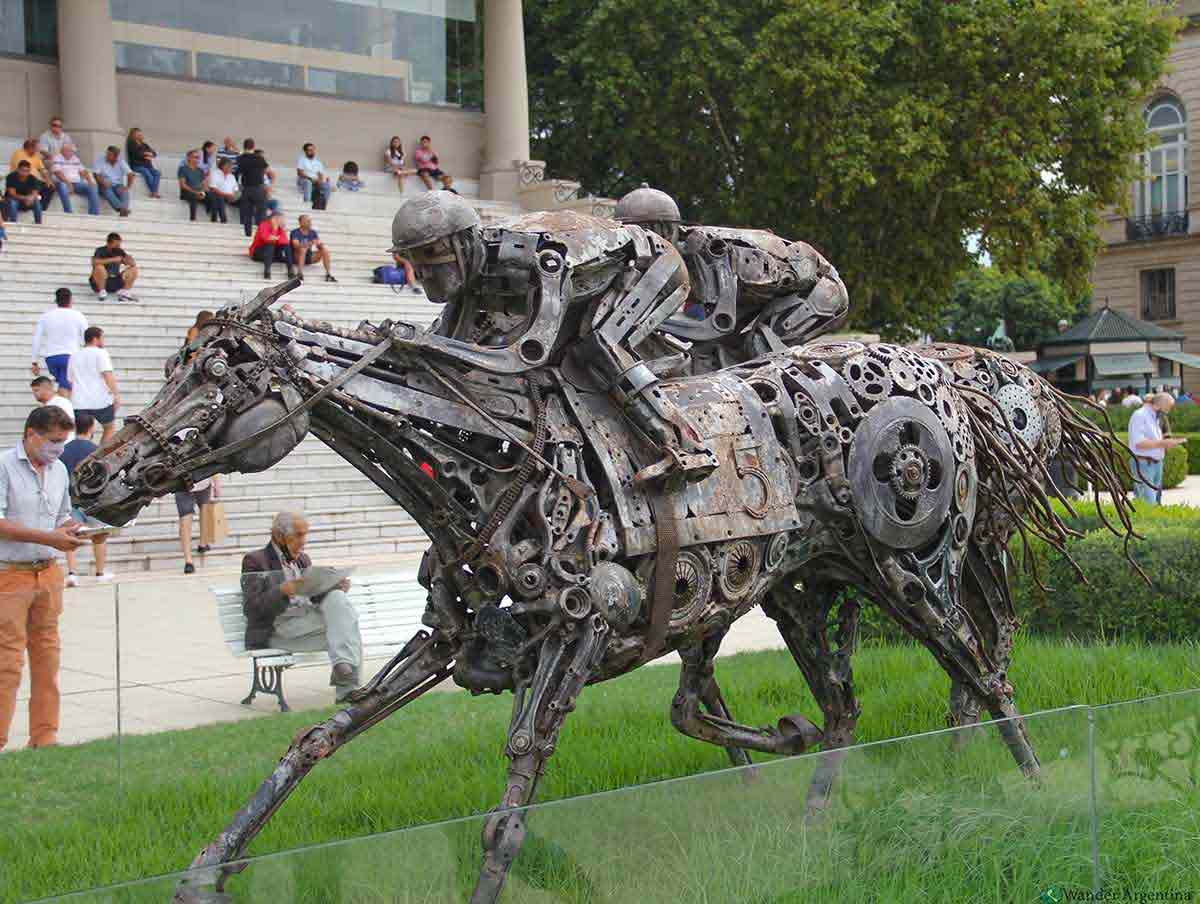
Gardel’s was set to star in the film featuring the story, ‘El Caballo del Pueblo’ (The People’s Horse) before his life was cut short in a plane crash.
Is Horse Racing a Dying Tradition?
Horse racing as a sport has been falling out of favor for over thirty years and continues to decline, although the Hippodrome has branched out to attract more than old-timey gamblers to the premises.
According to the US jockey Club only 22% of the public has a positive impression of the sport and it has also lost out to other forms of gambling and entertainment.
After 16 horses died at the Kentucky Derby in 2023, horse racing has come under further scrutiny.
Nevertheless horses are given performance enhancing drugs and are often pushed to their limits, sometimes resulting in fatal injuries.
Injured horses are often put down immediately and retired horses sold to slaughterhouse.
The group Horse Racing Wrongs estimates 2,000 horse deaths in total per year in the United States, a much higher number than Argentina.
The Jockey Club, who tracks equine injuries, say numbers of injuries have improved in recent years.
But in the old days, horsemanship was more sentimental. Carlos Gardel sent his beloved winning horse Lunático to a stud farm in Uruguay to live out his life.
The sport can also be fatal for jockeys. One died in 2020 and another in 2021 after falls at the Palermo Hippodrome.
Fortunes are made here, and horse racing has a deep aristocratic heritage in Argentina, so it probably won’t be put out to pasture in the immediate future.
Ancillary income comes from breeding Thoroughbred race horses, favored in for their speed, agility and stamina.
Argentina is the world’s fourth largest producer of these horses, and comes in at number three in the equine embryo market.
But the majority of the money made on the grounds of the Palermo’s hippodrome is from the ‘coin swallower’ machines and online betting — not horse races.
In terms of sheer numbers, the majority of the bets placed on races at the Hippodrome are actually placed in the United States, either online or at off-track betting (OBT) agencies.
The House Always Wins
In Argentina, a place moving so much plata (lots of silver) is sure to, erm, stirrup trouble.
In 2020 Panama Papers investigator, Mariel Fitz Patrick, reported the financial obfuscation of the Hippodrome’s owners to the tune of 70 million dollars.
The Argentine justice system is investigating HAPSA’s long and winding money trail — it’s not the first — and a related investigation was launched in the U.S.
Visit the Golden Age
Even if you’re not a horse racing enthusiast or a betting aficionado, the Hipodromo’s allure extends beyond the adrenaline of horse racing and tango lore.
The Hipodromo Argentino is an essential stop to discover the remnants of Buenos Aires ‘Gilded Age.’
Food and drinks at the Hippodrome
Rabieta Pub
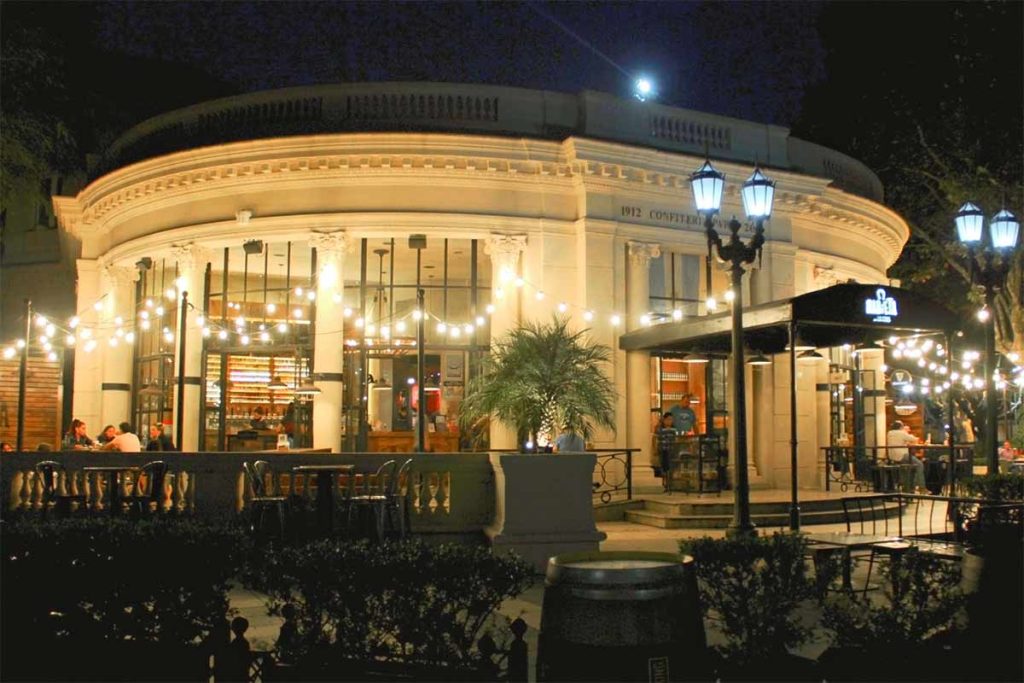
The pub Rabieta is located in the sprawling, elegant former home of La Confitería La París, built in 1912.
The brewery offers a large selection of artisanal beer and has a sprawling outdoor seating area.
Wine lovers will be delighted to discover they also have over 80 varieties of wine to try, primarily Argentina’s signature wine, Malbec.
It’s open every night until 2 a.m., except Sunday when it closes at 11 p.m.
Tuscon steakhouse
Tucson, named after the Arizona city, is one of two American-style steakhouses at the racetrack.
It’s reasonable assimilation of a standard USA-style restaurant serving up fried favorites with a nice view of the track.
The food is not outstanding, but meat lovers will discover they serve American cuts of beef (but make sure you order it right).
Kansas
Kansas is the other North-American style restaurant, popular with American expats who come here in droves on Thanksgiving.
It generally has better prepared American fare than Tucson — try a caesar salad or a bacon Swiss cheeseburger.
Berretin — a fast food cafeteria style that uses all paper and plastic in the basement of Tribuna Nueva. Don’t eat here. But if you do pizza is your best, er, bet. It’s open until 2 a.m.
Puracepa — Spanish food with a lovely terrace overlooking the track
Hours, Everyday 9 a.m. – 1 a.m.
Irineo Café on the second floor overlooking the racetrack, has everything from cocktails to sundaes and is open 24 hours a day.
Illy Café & Dolce — Located inside the official tribune, this cafe srves up Italian style coffee and desserts. Only open for lunch during the week and afternoons on weekends.
Getting to the Hipodromo de Palermo
The Hippodromo is only a twenty minute walk from Plaza Italia, in the heart of Palermo.
Several buses go by here including the 67, 37, 34 10, 130 and 160 and 166.
As for the subway, the D line goes close to the Hipodromo.
The closest subway stop is Mtro. Carranza, although the Palermo stop is also a short walk away.
The simplest way to get there is by taxi or a ride sharing app
Race Times & Cost
Races are in the afternoon, three or four days a week, with Monday being the biggest race day.
General admission: free.
VIP: Those who want the VIP treatment in the glassed-in balconies, only need to cough up some cash (approximately US$10-15) and abide by a not-too-demanding ‘smart casual’ dress code.
Hipodromo de Palermo
Av. Del Libertador 4101 (corner of Dorrego)
Tel: (54-911-4778-2800